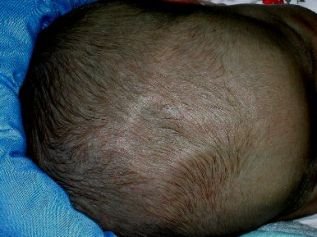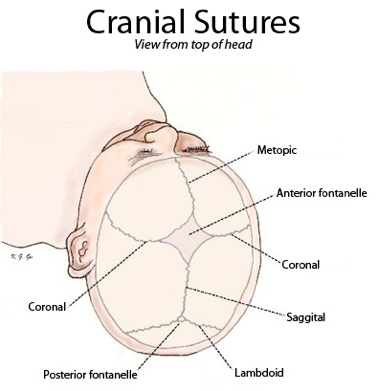The baby soft spot and what it can tell about your infant’s health
For a new mom, the soft spot on top of the baby’s head is often a reason for concern. A baby soft spot, or fontanelle, does not require any special care and is not as vulnerable as many parents believe.
Between the bones of the skull, a membrane protects the underlying brain and blood vessels. This membrane is very tough and capable of protecting it during your routine daily care (hair brushing and washing).
It is logical to be a bit nervous about touching a baby’s soft spot, especially as you can sometimes see it moving up and down.
Here are a few things you may like to know about your baby’s soft spot.
Why do babies have soft spots or fontanels?
A baby’s skull consists of 5 main bones connected with cranial sutures. They allow an infant’s head to change shape during delivery, making it easier for the baby’s head to pass through the birth canal.
Another reason there is space between the skull bones at birth is that the brain needs enough space to continue to grow. The little gaps between the bones are filled with a tough membrane known as a baby’s fontanel. The skull bones won’t fuse until the skull and brain stop growing, usually not before the baby turns two.
What happens if you accidentally hit a baby’s soft spot?
How delicate is a baby’s soft spot? Despite its name, the soft spot on top of a baby’s head is extremely tough and hard to penetrate. This fibrous membrane that covers the brain protects it very well. Accidents with penetrating injury are, luckily, sporadic events.

What does it mean if a baby has a sunken soft spot?
A common question among moms is why the baby’s fontanel is drawn in (sunken). When a fontanel is noticeably sunken, this is most often a sign of dehydration. Usually, when the fontanel is sunken, other dehydration symptoms like vomiting, diarrhea, and fever will have occurred before that.
Dehydration is a serious condition, meaning your baby doesn’t have enough body fluids. You can tell if a baby is dehydrated when he/she:
- has very few wet nappies
- cries without producing tears
- doesn’t drink
- appears listless
When this happens, the child needs medical attention right away.
Why is the soft spot bulging?
It is normal for a fontanel to bulge a little when a baby cries and strains to poop or vomit. But when the bulging persists, you may need to inform your doctor as it can be the first sign of serious conditions like meningitis, intracranial hemorrhage, and hydrocephalus. These conditions all cause increased pressure inside the skull.
Sometimes, a bulging soft spot can be a sign of Shaken Baby Syndrome. When you shake a baby, the underdeveloped neck muscles cannot control the movement of the head, going violently back and forth. This will make the brain bounce within the skull, and hemorrhage and swelling can occur.
Is a pulsing soft spot normal?
Sometimes, you can see the soft spot pulsing at the rhythm of the baby’s heartbeat (see the video below). If this worries you, you will be glad to hear that it is nothing serious. This pulsing is actually where it got its name from. Fontanelle is from the old French word “Fontaine,” which means fountain or little spring.
How many soft spots/fontanels does a baby have?
You may not know this, but a newborn of six fontanels.

Image by Xxjamesxx – Own work, CC BY-SA 3.0, Link
- Anterior fontanel or the diamond-shaped soft spot on the top of the baby’s head.
- The posterior fontanel is triangular and is at the back of the baby’s head.
- Two mastoids and two sphenoid fontanels. These are the lateral fontanels on each side of the head and the least notable.
You can expect the posterior fontanel in the back of the head to close when the infant is about 2 or 3 months old.
The anterior fontanel at the top of the head usually closes between 13 and 24 months.
What happens if a baby’s fontanel doesn’t close or closes too early?
Normally, with your regular check-ups, your pediatrician will check on your baby’s fontanel. They provide important clues about the baby’s health and development. The doctor will measure the baby’s head circumference to ensure the brain grows as expected.
Baby soft spots allow the brain to grow symmetrically inside the skull during the first years. This is why fontanels or soft spots usually do not close before your baby is 18 to 24 months of age.
When the soft spot closes before age one, or the baby’s head circumference doesn’t increase, your doctor may refer you to a specialist. Early closure (Craniosynostosis) must be monitored carefully as it can cause an abnormal head shape and is associated with abnormal brain development.
The fontanel size is different for every child, and some take longer to close than others. Delayed closure and a large fontanel can sometimes be associated with rare disorders, some of which involve developmental delay.
If, for some reason, you are concerned about your baby’s soft spot, do not hesitate to ask your pediatrician about it.
References
- The Abnormal Fontanel https://www.aafp.org/afp/2003/0615/p2547.html
- Shaken Baby Syndrome https://www.aans.org/Patients/Neurosurgical-Conditions-and-Treatments/Shaken-Baby-Syndrome
- The Importance of Baby’s ‘Soft Spot’ https://www.columbianeurosurgery.org/news/the-importance-of-babys-soft-spot/








The bottom line? If you have any questions or concerns about your baby’s soft spot, it’s a good idea to check in with your pediatrician to make sure all is well.